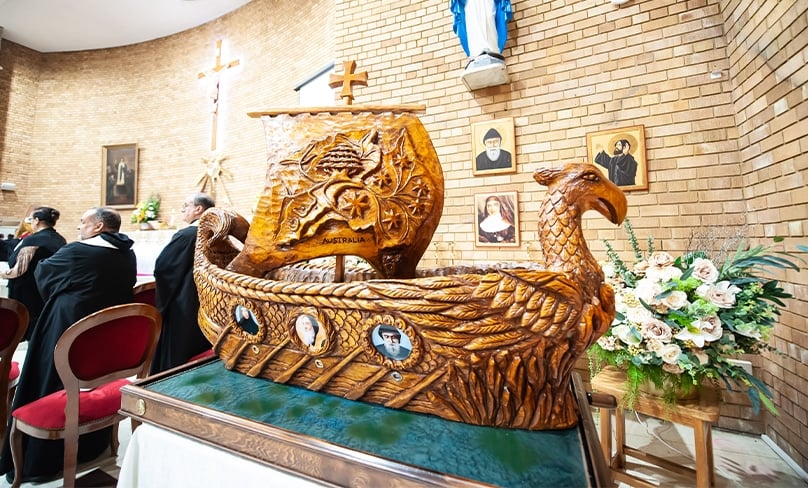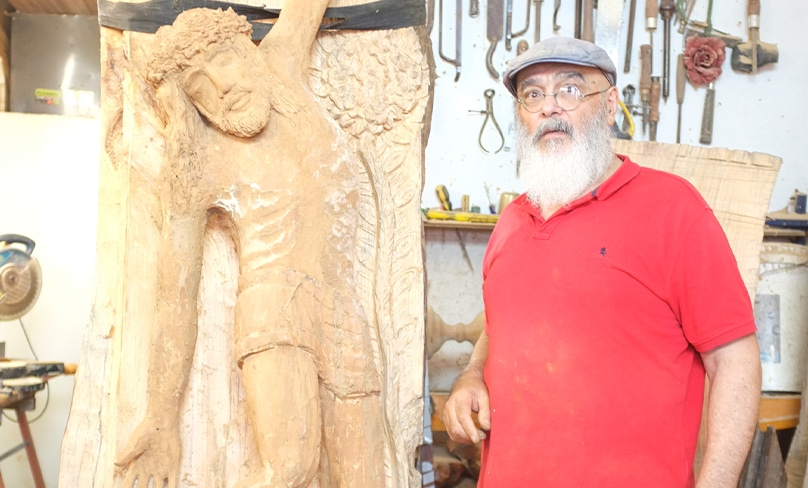
Thousands have gathered in scenes of joy and reverence to pray with the relics of five saints on a national tour to mark 50 years of the Maronite eparchy in Australia.
Among them is Salwa Elias, who says she was cured from a painful and crippling condition which plagued her for 12 years, after she asked St Charbel to intercede for her.
“The relics remind us of how wonderful God is in preserving holy people who are gone now but still assist us from heaven, and that we’re all called to be saints,” she said.
The tour of relics of Sts Maroun, Charbel, Rafqa, Nehmetallah, and Mary of the Cross MacKillop will visit all Maronite Catholic parishes and organisations as part of a year-long celebration, culminating in a visit from Cardinal Bechara Boutros Rai, Maronite Patriarch of Antioch and All the East.
Mrs Elias, a lay missionary and media professional, was leading a group to pray at the Shrine of Our Lady of Mercy at Penrose Park in 1998.
She had suffered from a bowel condition, causing chronic pain and haemorraging and requiring 15 surgeries over 12 years, and was hoping to be healed.
With her was her two-year-old son and newborn baby.
“My son started crying because he wanted me to pick him up and take him to the main shrine at the grotto and I cried because I could hardly walk myself,” she explained.
“As I walked past the little shrines, I saw the Maronite one with two statues of saints and just a picture of St Charbel, no statue.
“I knelt and I prayed for his intercession saying, ‘Please St Charbel, please heal me, I just want to be able to carry my son. If I am healed I’ll put a statue of you here myself.’
“The next morning I didn’t notice anything but started fixing the beds, getting the older kids off to school, put on laundry and hung washing out.
“When I finished and looked around, I suddenly realised all I’d done which I’d been unable to do before,” she said, wiping away tears.
“I just fell to my knees. I couldn’t believe it. I was healed, just like that.”
Two years later her son was four and terrified at the thought of having a large cyst removed from his eyelid.
“It was the size of a pea. The doctor said he needed surgery. But that night I said, ‘Let’s put this holy oil of St Charbel on your eye and ask God to heal you through his intercession,’ Mrs Elias recalled.
“He said ok, so we put it on his eye and again, the next morning, it was gone leaving a line on his eyelid as if someone had made an incision. He’s 27 now and tells people to this day, ‘Look at what St Charbel did for me’.”
The relics have been welcomed at parishes with scenes of dancing and singing, and profound reverence.
Sculptor Toufic Mourad spent more than two months painstakingly carving a magnificent reliquary from a single piece of cypress in his Canterbury studio in Sydney’s inner west.
Named “Sails of Faith,” the 80kg artwork forms the shape of a Phoenician ship laden with symbolic detail.

A phoenix at the head symbolises the power of Christ’s resurrection from death.
The ship’s sail features the Australian map. Within it is the map of Lebanon and a cedar tree, representing holiness, eternity and peace. Its roots stretch across Australia and to the Southern Cross, representing the whole Maronite eparchy.
It was established on 13 July 1973 and in 2021 expanded to encompass New Zealand and Oceania.
The relics of the five saints were placed in small holds where oars would typically be, representing their holiness as a source of energy which inspires the faithful’s journey to heaven.
Mr Mourad, who with his wife Lama offered the reliquary as a gift to the church, said that he had felt deeply moved to see the crowds venerating the relics at St Maroun’s Cathedral on the 9 February launch in Redfern.
He said many of them were in tears.
“I cried myself,” he said.
“People were responding to the relics and the spiritual meaning of the ship in a very real way. It means many things to them, and it made me feel that I had helped to make people very happy.”
Maronite Bishop Antoine-Charbel Tarabay said the tour is an opportunity for people to learn more about the saints’ lives and follow in their footsteps.
“It is also a time to reflect on and give thanks to the Lord our God, who has gathered us in faith and communion,” he added.
“It is my prayer that this jubilee year will awaken our faith to a deeper level, energise our spiritual fervour, and move our hearts to repentance and conversion.
“I also hope the year will warm our parishes with a renewed commitment to our faith in God and to our spiritual Antiochian Aramaic heritage as reflected in the life of the Church fathers and saints.”
Fr Kozhaya Sarkis, parish priest at St Rafqa’s Church in Austral, echoed the bishop’s sentiments and added that young people had shown an interest in learning more about their faith as a result of the relics’ presence there.
“They understand that we have a beautiful faith and tradition to be proud of and we are looking forward to having more new saints in our future,” Fr Sarkis said.
